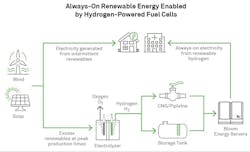Bloom Energy is Bullish on its New Hydrogen-Powered Fuel Cell
Microgrids often rely on solar-plus-batteries, combined heat and power, or back-up generators that run on diesel fuel or natural gas. But Bloom Energy says that it has just finished the engineering and testing for a “server” that uses renewable hydrogen produced by excess renewables that keeps electricity flowing.
“On a sunny day, when the microgrid’s assets or nearby wind and solar deployments have excess capacity, the operators can feed that excess to split water into hydrogen gas and oxygen gas, rather than export it to the utility,” says Arne Ballantine, vice president of Systems Engineering for Bloom, in an interview. “The hydrogen can be stored before it is run into a Bloom Energy server, or fuel cell, all to run a microgrid when the sun is not shining or the wind is not blowing.
“It’s all been tested,” he continues. “It is a vital part of the future. We think it is much cleaner and more reliable than if you had to fall back on diesel generators. We have finished the testing and it is ready now.”
Hydrogen is abundant, renewable and non-polluting. It is found mostly in water. But for it to be used efficiently by fuel cells, an isolated hydrogen source is helpful. When the hydrogen is separated, it takes energy. And then that hydrogen must be stored, which can either be in pipelines or tanks on site near the microgrids. Once it is in storage, the hydrogen can sit without suffering any losses.
The Bloom Energy servers today run mostly on natural gas or biogas as a fuel. But those servers can be upgraded to use renewable hydrogen, meaning wind and solar power would be used to split apart the hydrogen and oxygen. There would then be no fossil fuel impact.
What does this hydrogen technology mean for solar-plus-storage? There will certainly be a number of battery solutions, Ballantine says, but hydrogen-powered fuel cells will become more prevalent and a notable part of the mix.
“If we make hydrogen from water, we will have to spend energy to get that done,” Balantine adds. “We will have to spend more energy to compress and store it. But once it is done, it will sit there happily until it is time to use it. Once we go to electricity, however, we lose some efficiency,” meaning not all of the energy input is converted to electricity.
“When you charge and discharge a battery,” he continues, “There is also a round trip efficiency loss. From the technical side, it will be comparable economics.”
Track news about fuel cell microgrids. Subscribe to the free Microgrid Knowledge newsletter.
About the Author

